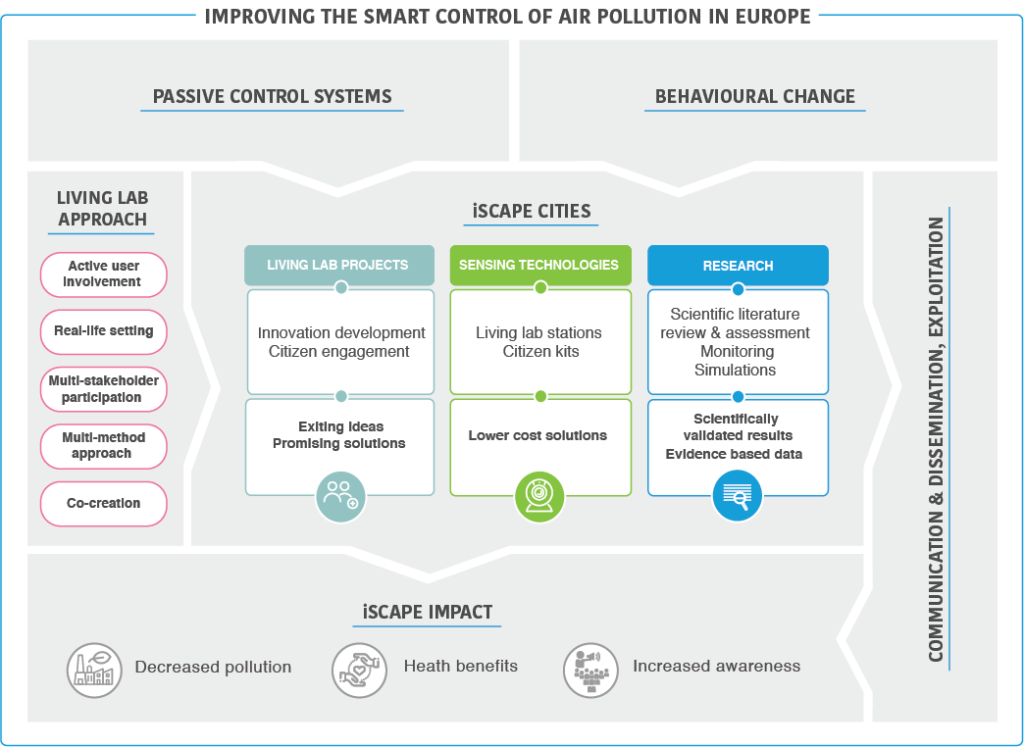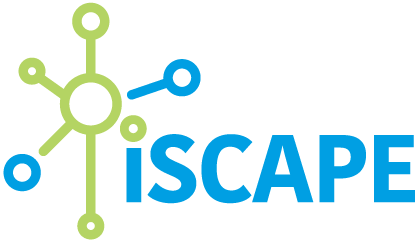
Research approach
The iSCAPE project aimed to provide the means to achieve an air pollution free (and low carbon) society through the application of new sustainable methods and approaches integrated into urban design and policy guidelines. To achieve this, the iSCAPE concept was based on the following:  The workflow of the project was driven by two main solutions, Passive Control Systems and Behavioural Change, and it gathered the tasks into three blocks of implementation. The first one dedicated to the deployment of the pilots in the cities, kicked off with a thorough and neutral assessment of existing and future challenges and opportunities for the cities with respect to air quality and climate change, and the role of infrastructural interventions to offer solutions to the corresponding challenges to be carried out. Once the possible solutions were identified, a dialogue with the citizens of each test city and relevant stakeholder was initiated through Living Labs, to assess non-technical challenges to implementation of both the physical and behavioural interventions that were to be implemented or assessed in iSCAPE. These activities were integrated with the use of Sensing Technologies and the development of two quality monitoring kits: one to assess the effectiveness of the implemented solutions to improve air quality (high-level monitoring kit) and one to involve and educate citizens (low-cost monitoring kit) as part of the activities which were hosted at the Living Labs. In parallel, a design and evaluation campaign was necessary to assess the effectiveness of these solutions for different climatic conditions related to location and seasonality. As such, iSCAPE focussed on Research activities and the running of air quality and meteorological simulations at various scales to preempt the effects and improve the impacts of these solutions and an extensive monitoring to assess the effectiveness of such solutions. This evaluation was complemented by simulations which were deemed to have a direct impact on population behaviour, including a bottom-up feedback for policy makers by linking anthropogenic urban activities to environmental models for providing new insights on how traffic policy measures need to be designed to improve environmental quality. These three blocks of activities were strengthened by examining the strategies needed for the overall transition to successful exploitation and policy instruments and priorities and by integrating the results of all the work packages for the dissemination and communication process.
The workflow of the project was driven by two main solutions, Passive Control Systems and Behavioural Change, and it gathered the tasks into three blocks of implementation. The first one dedicated to the deployment of the pilots in the cities, kicked off with a thorough and neutral assessment of existing and future challenges and opportunities for the cities with respect to air quality and climate change, and the role of infrastructural interventions to offer solutions to the corresponding challenges to be carried out. Once the possible solutions were identified, a dialogue with the citizens of each test city and relevant stakeholder was initiated through Living Labs, to assess non-technical challenges to implementation of both the physical and behavioural interventions that were to be implemented or assessed in iSCAPE. These activities were integrated with the use of Sensing Technologies and the development of two quality monitoring kits: one to assess the effectiveness of the implemented solutions to improve air quality (high-level monitoring kit) and one to involve and educate citizens (low-cost monitoring kit) as part of the activities which were hosted at the Living Labs. In parallel, a design and evaluation campaign was necessary to assess the effectiveness of these solutions for different climatic conditions related to location and seasonality. As such, iSCAPE focussed on Research activities and the running of air quality and meteorological simulations at various scales to preempt the effects and improve the impacts of these solutions and an extensive monitoring to assess the effectiveness of such solutions. This evaluation was complemented by simulations which were deemed to have a direct impact on population behaviour, including a bottom-up feedback for policy makers by linking anthropogenic urban activities to environmental models for providing new insights on how traffic policy measures need to be designed to improve environmental quality. These three blocks of activities were strengthened by examining the strategies needed for the overall transition to successful exploitation and policy instruments and priorities and by integrating the results of all the work packages for the dissemination and communication process.
